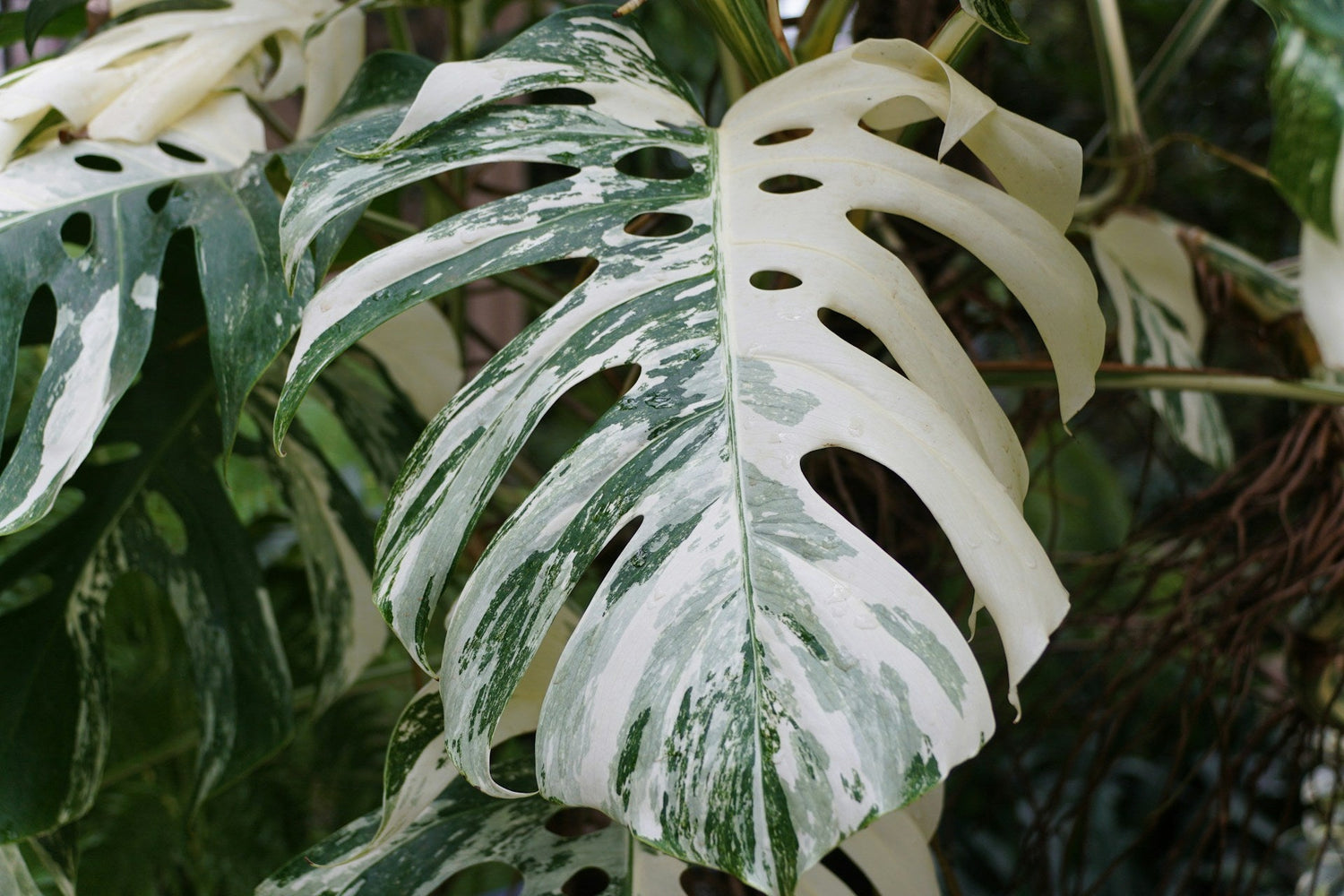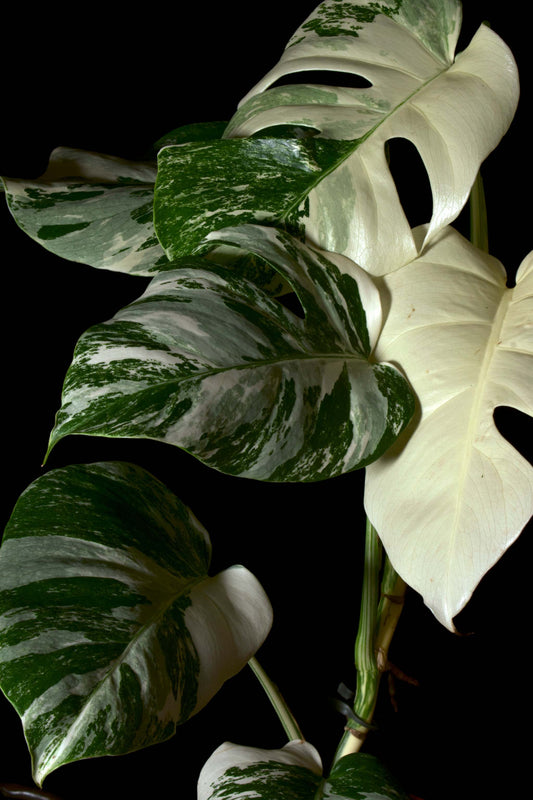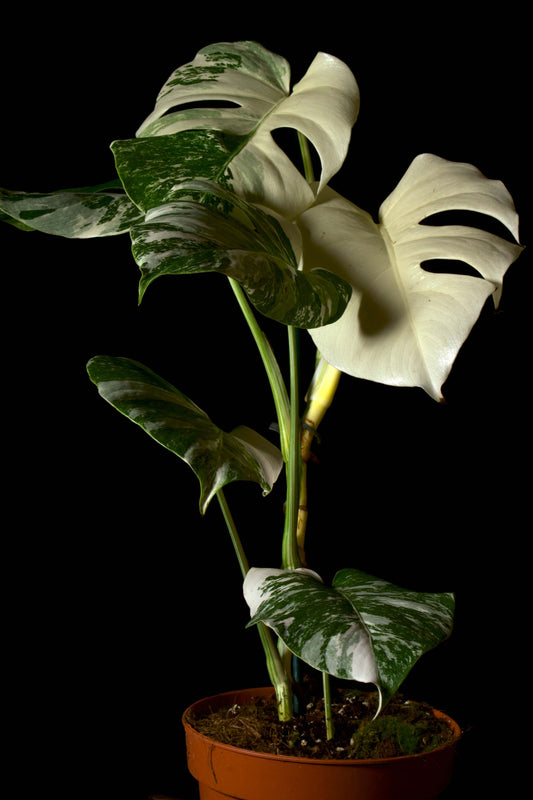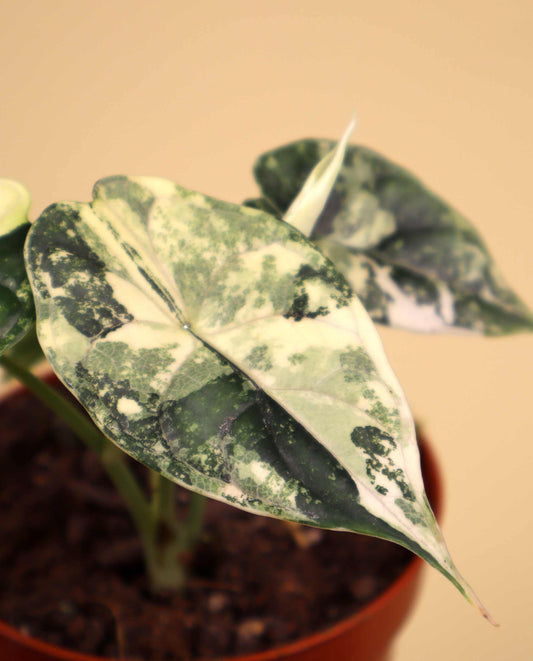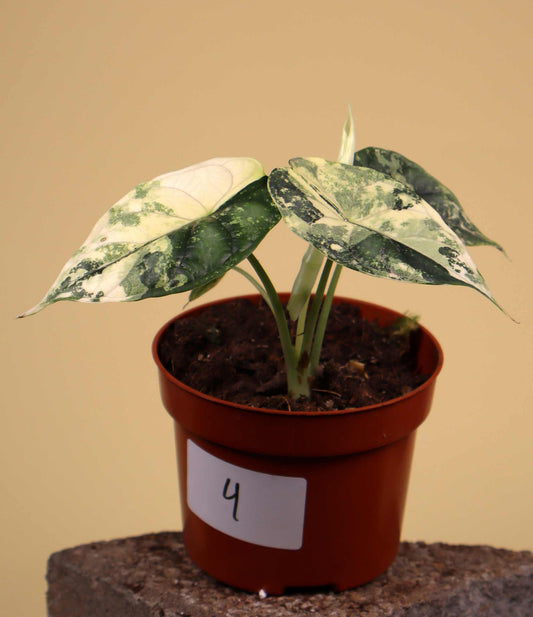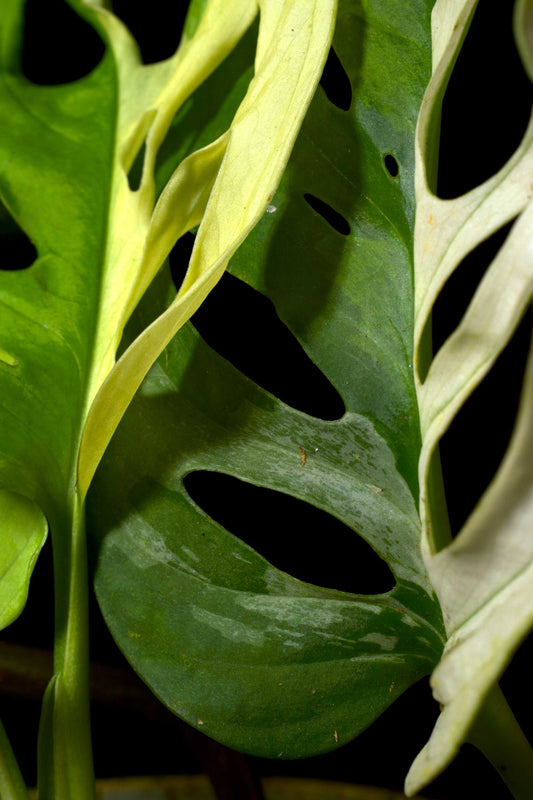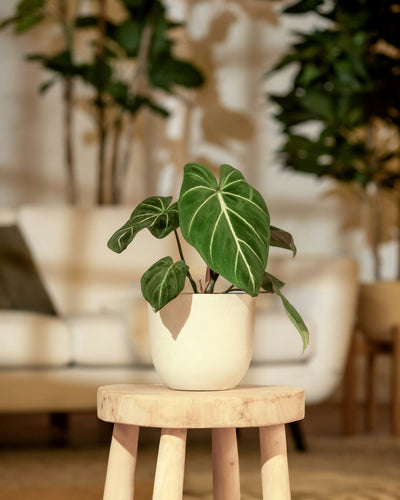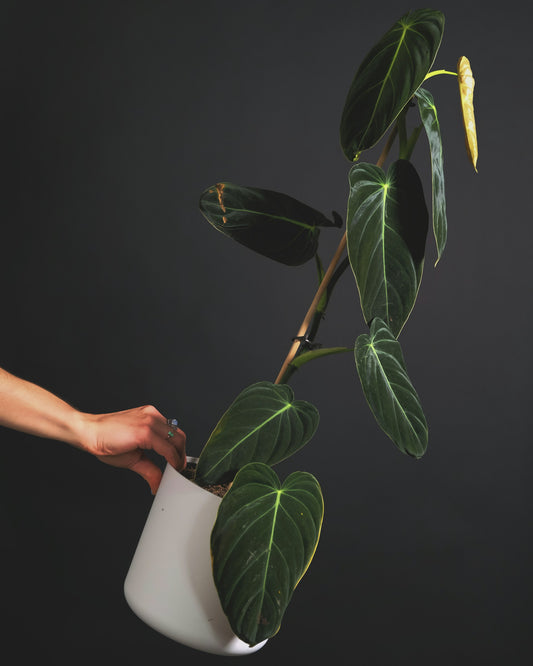Share
Care and advice | The collector's plant: Monstera variegata
Monstera variegata is a so-called 'variegated' houseplant. The white-green leaves are caused by a rare mutation. The white part of the leaves is what we call 'variegated' and means a lack of chlorophyll. The pigment that makes green plants green.
Why is Monstera variegata so expensive?
Monstera variegata is very sought after due to this mutation. This means that the price often reaches several thousand kronor per plant. In addition, the lack of chlorophyll on parts of the leaves means that it grows slowly and takes a long time to propagate.
The high price means that Monstera deliciosa variegata is sometimes seen as an investment. Especially if you plan to propagate several of these plants by taking cuttings. Do you want to be able to sell your own cuttings? Read on and we will go over tips for growing this unique plant.

How often should you water a Monstera variegata?
Giving advice on how to water your variegated monstera is not as simple as saying, 'water once a week.' This, unfortunately, often common way of giving care advice often ends in root rot and a dead plant.
How not to kill your Monstera. Step 1.
We usually give advice on how to care for plants based on your specific conditions . Watering when the soil is dry is a much more useful concept to work from. Absolutely do not water your plants on a fixed schedule, such as once a week.
We usually water our monsteras when the top 2-3 cm of soil feels slightly moist and when the weight of the pot feels lighter than usual. Don't be afraid to lift your monstera variegata out of its pot and feel the soil if you are unsure. The soil should never be wet , except if you are using, for example, an orchid soil or hydroponic growing medium.
If you are unsure, it is better to wait a little than to water too much, as overwatering can lead to root rot . Water droplets on the leaves or yellow leaves are often signs of too much water.
With an airy soil, specially adapted for monsters like our Aroid & Orchid soil , the soil can be allowed to be wet. We will not go into the difference between different types of soil and their meaning below.
When and how you water depends mainly on these 4 factors.
1. Season
In winter, the sun is weaker and the elements are often on. This leads to dry air indoors and a plant that has slowed down its metabolism when the light is low. It is also colder, which often means that it takes longer for the soil to dry out.
However, if the plant is placed on a windowsill above a radiator, the soil can paradoxically dry out faster than in the summer. This is where the advice about watering when the soil is dry is particularly important, as it varies depending on where the plant is placed.
2. Indoor temperature
In the summer, the temperature is often higher indoors and the humidity is high. If your monstera variegata is in a warm window, there is a high risk that you will need to water it several times a week. If the plant is indoors, protected from the heat, it may be enough to water it once every two weeks. Again, be careful not to have a watering schedule. If the soil is not dry enough, do not water.
3, The size and type of pot
A small Monstera variegata in a large pot will need to be watered less often than a large plant in a small pot. As a rule, a Monstera variegata should be placed in a pot where the roots fill almost the entire pot.
Unlike many other plants, houseplants, such as monstera, actually thrive in a smaller planting pot where the roots barely fit in. The reason for this is that monstera actually only partially grows in the ground naturally.
This tropical climbing plant is a so-called 'epiphyte' which means that it often grows completely without soil. The roots of the monstera are adapted to this and prefer to thrive in a pot with more roots than soil. This also helps you when you have to water your monstera because the soil dries faster and more evenly . This significantly reduces the risk of root rot and leads to easy watering.
As a rule of thumb, you should n't plant a monstera with too much soil in the pot. If there aren't enough roots to soak up all the water, the roots will sit in wet soil for too long, which means, you guessed it, a sad or perimortem houseplant.
4. The Earth.
The soil the monstera is planted in has almost the greatest impact on how and when you water it. When you buy a new plant, the soil from the grower is usually of a type suitable for growing in a warm and humid environment, as is often the case in large greenhouses. However, this soil is less suitable for growing indoors , at home. There, the air is often dry, the temperature is lower and the light is weaker.
Switching to a well-drained soil like orchid soil can be very beneficial and can be crucial in the future of your 'variegated brother'. This type of soil will create air pockets around the monstera's thick roots which have a tendency to rot without air.
We use a mixture of about 1/3 sphagnum moss to hold moisture, 1/3 perlite to make the soil well-drained, and 1/3 orchid bark to leave air pockets. This, plus peat-free potting soil, allows you to water frequently, almost as often as you want.
The roots can thus be kept moist while not rotting because excess water flows straight out through the pot's holes.
If you plan to use regular potting soil, we recommend that you mix the soil with at least 1/3 perlite .
P.S. Trying to grow monstera variegata in ordinary potting soil is punishable according to §3 Fern care guidelines.
Extra tip!
A fun trick is to try bottom watering : fill a bowl with lukewarm water and place the pot in it. Let the plant soak up the water for a few minutes, it will only take as much as it needs. Remember to occasionally water from above to help aerate the soil.
Can Monstera variegata be grown outdoors?
Monstera thrives in temperatures between 21-29 °C. However, the plant can handle slightly cooler temperatures down to around 16 °C, but growth slows down below that. Below 10 °C, the plant risks damage, yellow leaves and, in the worst case, growth stops.
Tropical houseplants like monstera should not be placed outdoors, even in summer. However, monstera can thrive very well and grow very quickly in a greenhouse from spring to late summer.
Humidity is also important; aim for around 60-70% humidity to keep the leaves healthy and green. Low humidity can lead to dry and brown leaf edges. Brown leaves can also be caused by other things, which we will go over in the next section.

Why does Monstera variegata turn brown on its leaves?
Your plant's brown edges or completely brown leaves can be caused by a variety of factors. Here are some simple tricks you can use to figure out what the problem is.
- New leaves turn brown: There is a high risk that you are overwatering the plant. Another reason could be that you have pests such as thrips, spider mites or scale insects.
- Old leaves turn brown: If the plant is dehydrated, the older leaves will turn brown . Old leaves turning brown can also be caused by too little light .
- One side of the plant is getting yellow leaves: Too much sun causes brown leaves on parts of the plant that are facing the grow light or window.
- Yellow spots on the leaves: If your monstera has yellow or brown spots on the leaves, the risk of having pests is relatively high. Look especially for signs of thrips (small black oblong insects often found under the leaves) or mealybugs (white oval insects).
- The white part turns brown: It is completely normal for the white parts of the monstera to turn brown from the edge inwards and is almost impossible to prevent. One way to reduce the risk is to increase the humidity and not get the leaves wet. The plant sometimes sheds completely white leaves because they do not provide the plant with energy through photosynthesis. However, it is easy to cut away these brown parts, which are rarely more than an aesthetic detail.
When does Monstera get lobed leaves?
Monstea variegata has lobes and holes in its leaves just like the green 'common monstera'. The holes are called fenestrations and are not only beautiful but have an important function. The fenestrations help the monstera to capture as much light as possible in its natural environment, where light can be limited.
The holes allow the leaves to spread out and still let in light, which increases the chances of photosynthesis. In addition, the fenestrations can help let water through during heavy rains, reducing the risk of the plant becoming flooded.
How to get hollow leaves fast!
A small Monstera variegata starts out with small leaves without holes. The leaves have to grow larger and only then will the characteristic lobes and holes of the leaves develop . It can sometimes take several years for the leaves to get their holes but there are some tricks to speed up the holes.
- Replant your monstera variegata into a large plastic pot to give the roots more space. This will allow the monstera to form large leaves with lobes.
- Give your monstera a plant support to anchor its aerial roots on. This will help the leaves grow larger much faster.
- Give the monstera enough nutrition , otherwise the growth of the leaves will be very slow. You can either water with liquid plant nutrition or do as we do and mix the soil with worm castings.
- Place your monstera so that it gets enough light to grow quickly. A monstera without enough light will stop growing and the leaves may even become smaller.

Give your monstera variegata a plant support to get large leaves
Which pot is best for monstera variegata?
Monstera deliciosa variegata usually needs to be repotted every 1-3 years . When repotting your plant, it is a good idea to use orchid pots with good airflow to avoid root rot.

12cm orchid pot, especially suitable for all types of Monstera.
Orchid pots are clear plastic pots that have more drainage holes than regular plant pots. This allows you to monitor the health of the roots right through the pot without having to lift the plant out of the pot. White roots mean you are watering correctly, while brown or black roots are a sign of root rot and frequent overwatering.
We have several cheap transparent plastic pots for sale here .
Get more variegation by taking cuttings.
Propagating Monstera variegata is easy. You can take either top cuttings or stem cuttings, but top cuttings grow faster and often root more reliably and are therefore preferable.

Take a cutting with at least a couple of leaves and a node and start in water or sphagnum moss for best root development.
How to take cuttings.
1. Top cutting:
A top cutting is taken by cutting the plant with at least one node from the top of the growth. That is, where new leaves emerge. It doesn't hurt to have an aerial root included, but it is not a requirement for the cutting to establish.
2. Stem cutting.
A stem cutting is taken by cutting a piece of the stem that contains at least one node but unlike a top cutting does not contain the top of the plant. The top of almost all plants generally has the most growth hormones and therefore sees the most growth. By taking a stem cutting, the plant must start a new growth point which occurs at a node.
What is a node?
A node is a part of the stem of many cold-hardy plants, including Monstera variegata, that must be present when you cut cuttings. This part of the stem looks like a small bump around the stem with regular intervals of smooth stem in between. It is from these nodes that new shoots, leaves and roots grow. A cutting without a stem can survive for a while in water but will never grow into a new plant.

The picture shows variegation on the stem and an aerial root growing out of a node.
Choose the right node to increase the amount of white spots 'variegation'.
Each cutting taken will be a genetic copy of the parent plant, but by selectively propagating cuttings you can increase the variegation. Each node has an 'eye' which is where the new growth will occur. By choosing an eye with visible white spots on it , the new plant is more likely to have a lot of variegation.
Place the cutting in water or orchid moss under bright indirect sunlight or under a grow light and keep the environment moist. Once the roots have grown, the cutting can be planted in soil and a well-drained orchid pot. With a little patience, you can have a whole collection of these unique and beautiful green indoor plants.

You can buy orchid moss for your cuttings here!
The same applies when cuttings are taken that have very poor variegation across the eye and will sometimes grow into completely green monsters.
Monstera variegata has a very variable variegation and can actually turn completely green again if not cared for properly. With proper care, there is a possibility for the plant to turn more white.
There is no one-size-fits-all advice for promoting more variegation. If you care for the plant as we go through in this guide, the plant will thrive and often maintain or increase its variegation naturally.
LED lighting for Monstera variegata
Monstera deliciosa variegata benefits from supplemental lighting because the plant needs light to maintain its unique variegation.
It is good to know that Monstera variegata needs more light than the all-green variety, because the white parts of the leaves do not contain chlorophyll and therefore cannot contribute to photosynthesis.
Lack of light can even cause the beautiful variegation to disappear and the leaves to become completely green. But remember, too much direct sunlight can damage the leaves and cause sunburn.
To reduce the risk of this, it is important to give your variegated plant enough light. Cheap plant lighting with LED plant lamps is a very good alternative if you do not have bright windows at home. The price of these has become much lower over the years and is now a very affordable alternative to a new apartment with a sunny location.
Vermin and pests
Monstera can be affected by spider mites, thrips and mealybugs. Use beneficial insects against thrips, spider mites and other pests or treat with another pesticide. Housewives' tricks such as soapy water often do little and require a lot of work to get rid of, for example, thrips.
What are thrips?
Thrips are small black or brown, oblong insects about 3mm long that thrive under the leaves. They pierce the plant and feed by sucking nutrients from the leaves. Thrips can be very difficult to get rid of and are resistant to many different types of pesticides. An effective approach to protecting your plants from pests is to work preventively.
It is common to bring home small nasty bugs when you buy new plants and it is actually part of growing houseplants. Insects are naturally occurring and if you don't get thrips from new plants there is a risk that they will fly in through the window on a summer day.
Useful animals - Let nature do the work
Beneficial insects are small predatory insects that feed by hunting and killing many different kinds of pests. They often come in small bags that you simply hang on your variegated monstera. Slowly, over the course of about 6 weeks, depending on the type of beneficial insect, they crawl out of their little house and keep your houseplant free of pests.
You can order these many different farm animals from our website here, with free shipping!
How do you get a Monstera variegata?
If you want to buy a Monstera variegata or other popular houseplants online, check out our selection. Here you will find unique plants, soil for Monstera, practical plant supports and beneficial animals to combat pests such as thrips.
With the right care and maintenance, your Monstera can be a fantastic addition and maybe even a little bit of a cash cow.
Create your own tropical oasis with green indoor plants and enjoy the timeless beauty of the unusual houseplant Monstera variegata! You can buy the exact plant you see in the picture here.

